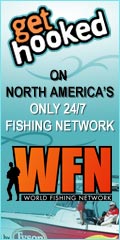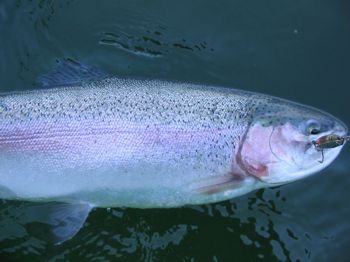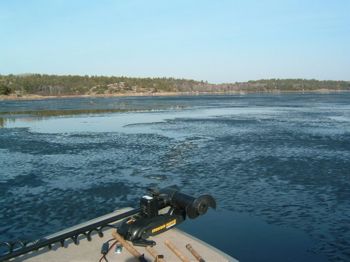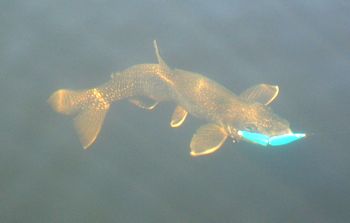
Click Here
|
 Temperature,
Tackle and Techniques Temperature,
Tackle and Techniques
Early Season Longlining For Trout From The Gardiner Expressway To
God's Country
by J.P. Bushey
Your boat
works around a small, rocky knob along the shoreline, and the warm,
offshore breeze immediately dries up. With no more chop music on the
hull, the only sounds are songbirds flitting in the naked hardwoods
and melt water's crisp daytrip down the land and back into the lake.
Shade from big cedars, pines and sharp overhangs has kept snow alive
in brilliant patches amongst the black, grey and pink rock. Light
jackets and sweaters instantly come off. The land is sweating, and
so are you. After months of ducking bad winds and fooling with
frozen reels, this kind of day is reason enough to love spring
trolling for trout. But it gets better. A reel's drag slips when the
stretch leaves a mile of light mono. A long, soft rod bucks to life,
and a heavy fish digs in.
Not every
spring day will give you perfect weather, and longline trolling
isn't the only way to put trout in the boat. But from rainbows to
browns, lake trout to brookies, you can enjoy some great,
light-tackle fishing with the boat in gear and the lures a long way
behind you in the days, weeks and even months following ice-out.
Trout in cold, spring water fight hard, release well, and blow out a
winter's worth of cobwebs like nothing else. Trolling habitat varies
dramatically in Ontario. Fishermen on the Great Lakes check
warm-water plumes near large, inflowing rivers or industrial
outflows, while northern fishermen find their warm water in back
channels, shallow bays or between islands. Piers, breakwalls and
other man-made features are to the urban troller what shoals,
saddles or rock walls are to their brothers up on remote water. The
scenery changes, but the basic program doesn't change much. Whether
you're trolling from a twenty foot hardtop rig or a twenty year old
canoe, you can apply similar patterns wherever the fun takes you.
Long before
the thermocline has formed, water still experiences temperature
differentials. Even though it's fragile, warm water zones can and
will form. As quickly as they arrive, these pockets can just as
easily get blown apart with the wrong winds or big drops in air
temperature, especially overnight. Warm, calm weather raises the
surface temperature in the upper few feet, especially as the days
get longer and longer. But this is a fluid relationship, changing
literally overnight, sometimes. Run off and inflowing tributaries
are a much more consistent source of warmer water. Coloured water,
as well. Dirty water can make trout more at ease, and it sucks up
more of the sun's heat than clear water will. Just as rain and
runoff triggers inshore migrations, those same conditions get fish
moving in the spring.
 Anywhere
you can find patches of trapped water in warm, stable weather, you
can start checking for trout. On natural lakes, these spots can be
big coves behind points, long channels, bays or protected saddles
between land masses. Water that's stable and undisturbed is easy to
spot with the naked eye. It can have a scummy appearance, with tree
pollen, runoff debris or insect casings coating the surface. Water
that's been beaten by wind will look cleaner and of course, colder.
Mid-day surface temps in these types of spots can creep up to 42 or
43 degrees when the open areas are still in the high thirties. Baby
steps in temperature makes a huge difference at this time of the
season. Actually, early spring and late fall are the only times all
year when I put any serious stock in surface temperatures. And in
both cases, the comfort level of gamefish isn't my main focus. It's
the food chain. Anywhere
you can find patches of trapped water in warm, stable weather, you
can start checking for trout. On natural lakes, these spots can be
big coves behind points, long channels, bays or protected saddles
between land masses. Water that's stable and undisturbed is easy to
spot with the naked eye. It can have a scummy appearance, with tree
pollen, runoff debris or insect casings coating the surface. Water
that's been beaten by wind will look cleaner and of course, colder.
Mid-day surface temps in these types of spots can creep up to 42 or
43 degrees when the open areas are still in the high thirties. Baby
steps in temperature makes a huge difference at this time of the
season. Actually, early spring and late fall are the only times all
year when I put any serious stock in surface temperatures. And in
both cases, the comfort level of gamefish isn't my main focus. It's
the food chain.
As we've all
heard over and over, these types of conditions gather and support
the microscopic life that baitfish and insects feed on. (On the flip
side, dropping water temperatures can trigger massive forage
migrations in the fall as they seek out shelter or spawning
habitat.) Nothing revolutionary here. These processes could be the
subject of a hundred articles. It's my belief that in spring, lakers,
rainbows, browns and other species are using warm water as feeding
stations first and foremost. They're worth finding, because trout
can be grouped up just like they are in fall, and you can get into
them early and often. This is especially true of smaller, warm areas
that are cut off from larger, colder zones.
Is open water
(or deep water, for that matter) unproductive? Not at all. Colder
patches of water can still produce, and the right weather leading up
to your trip can spread trout over big areas. Anytime you get
'superficial' warming of the lake's upper few feet, trout can really
stretch their legs, and their food can be all over. By superficial,
I'm just referring to temperatures that are raised solely through
combining direct sunlight and calm winds, rather than through
structural isolation or inflowing water. Remember, these spots will
resist big drops better.
Smelt,
shiners, alewives, ciscoe, suckers and perch are all drawn by their
food and with the exception of ciscoes, their desire to spawn at one
time or another. Forage varies a lot depending on where you're
fishing. In some northern lakes, stocked rainbows, splake or wild
lake trout might only have minnow species like suckers or
stickleback to follow. Whatever your sonar shows high over deep
water or in shallow water, fish it. At this time of year, any
activity is good activity. But in clear water especially, adjust
your thinking when it comes to sonar interpretation. In the simplest
terms, you can catch fish when there's nothing showing on the
screen. Even the best units have a hard time showing clear signals
in the upper four to five feet of the water. Trout will also scatter
from the boat as it passes over or near them. With a longline
approach, they can settle down and regroup by the time your lure
gets there. Naturally, low trolling speeds and in-line planer boards
are a fantastic approach here. You'll be amazed at how many fish you
can catch while the screen is totally blank. Little clumps of
isolated activity here and there are all I need to confidently work
and rework an area. Those fish are in there. Of course on other
days, you'll locate huge smudges of baitfish and predators on the
screen, too.

Ice Out Tackle!
No matter what
you're trolling for, with what lure or in what season, depth, speed
and direction changes are going to be what makes it all come
together. Great Lakes fishermen can run two rods apiece. This is a
tremendous, tremendous asset for finding the trout and figuring out
what they're interested in. Two in-line planer boards with
shallow-diving baits, run off opposite sides of the boat will cover
the surface. In between, one rod with a deeper diving flatline is
offset by another with weight or a small, diving planer like a Jet
Diver or Dipsey. By all means, run your downriggers if you have
them, focusing on the top 1/3 to 1/2 of the water column. In clear
water especially, multiple depths can be hot all day, where trout
can see a long way. I've had days outside Owen Sound Harbour when
rainbows and lakers took turns hitting A.C Shiners eight feet down
and Sutton West River Spoons fished past twenty feet with 3/8oz keel
weights. Fish in dirtier water usually exhibit much tighter depth
tolerances. Hot colours, banging the bottom and baits with rattles
are three ways to trigger trout where visibility is low. This
certainly isn't anything new. Slow-crawling is effective at all
times in the early season, and it can be really key in water that's
badly roiled by current/run-off or waves.
Always try to match lures with complimentary speeds. In-line
spinners and minnowbaits are really flexible. Bananna-style lures,
like Flatfish or Apex are a little more sensitive. Spoons also have
a much narrower speed range than jointed minnowbaits, for example.
At the end of the day, I like to move slowly overall at this time of
year, from 0.5 mph to 1mph, so lure-matching isn't as critical as it
is when you're fishing faster. Planer boards will really wander out
the slower you troll, speed sucks them back inline with the boat.
Lures with heavy vibration and/or rattles can be just as effective
as those that move quietly and delicately.
 If
you take nothing else from this article, remember one thing:
salmoniods can tune into specific colours and sizes as acutely as
any fish that swims. I've seen it time and time again. I'm sure that
the depth and the speed each magic lure runs at is very important
too, but when the fish get onto a specific lure pattern, expect them
to wear the paint off of it until they stop hitting it. And they
will stop hitting it. The drought might last a few hours or right
through next season, but all good things do come to an end sooner or
later. One day, it will be hot orange, J-11 Rapalas. The next, 2/5oz
Cleos in gold/red. Then X4 skunk Flatfish will be the only game in
town. Fish tuned into one or two specific baits can make the others
seem like a waste of time. I guess at one time or another all fish
species do this, but it seems really pronounced with the trout. I
carry a good range of trolling baits, from tiny, dressed spinners to
large, jointed plugs in hot colours. If
you take nothing else from this article, remember one thing:
salmoniods can tune into specific colours and sizes as acutely as
any fish that swims. I've seen it time and time again. I'm sure that
the depth and the speed each magic lure runs at is very important
too, but when the fish get onto a specific lure pattern, expect them
to wear the paint off of it until they stop hitting it. And they
will stop hitting it. The drought might last a few hours or right
through next season, but all good things do come to an end sooner or
later. One day, it will be hot orange, J-11 Rapalas. The next, 2/5oz
Cleos in gold/red. Then X4 skunk Flatfish will be the only game in
town. Fish tuned into one or two specific baits can make the others
seem like a waste of time. I guess at one time or another all fish
species do this, but it seems really pronounced with the trout. I
carry a good range of trolling baits, from tiny, dressed spinners to
large, jointed plugs in hot colours.
In water where salmon are present and possible, be ready for them.
Even in ice-out conditions, they're still fully capable off emptying
a lightweight reel with light line. By the same token, small lakes
where fish run smaller are a riot with ultralight rigging. Make sure
you've got reserve capacity after you've let out between 150 and 250
feet of line. For flatlines, long, soft rods give you good spread
away from the boat, and wear down fish quickly. Diving and side
planers are typically fished with line-counter reels, monofilament
and rods that are long and soft. I've been using planning devices
for trout and salmon for about twenty years, and prefer springy,
stretchy mono over zero-stretch line. Easier to rig in the clips and
fish simply don't get away. I had a guest on board one time for
rainbows with his brand new 11 foot steelhead rod and six pound
Fireline. I went 9/9 that morning while he boated one of four. He
ran the tiller while I swapped out his reel and re-rigged with one
of mine with six pound mono. I'm not sure if he enjoyed driving the
boat for those few minutes or not, but he definitely enjoyed me
netting his next five trout in a row for him as our afternoon rolled
along. (One rainbow and four lakers.) Watch any underwater videos
you can get your hands on that show trout or salmon hitting trolled
lures, and you'll see why line stretch isn't a bad thing.
I carry diving planers, side planers, weights and spare clips in
large, plastic tackle cases in a tackle bag. Weights range from
BB-sized splitshot to one ounce keelweights. A second tackle bag
contains four or five divided cases with my lures.
Stubby-profile lures and slim profile lures. Wide wobbling and tight
wobbling. Natural finishes as well as hot colours. Willow leaf
blades and Colorado blades. Baits with rattles, baits without.
Suspenders and floaters. Everyone's got their favorites, and in the
spring, I normally carry the whole ball of wax because fish can
really lock into certain lures, like we talked about. Crankbaits and
minnowbaits are some of the most effective, but they're rougher on
the fish than single-hooked spinners or spoons are. You can run
small Siwash hooks on certain plugs, though. Flatfish and divers
like the Shad Rap are two examples off the top of my head. Spring
after spring, jointed and suspending Rapalas, Bomber Long A's,
Rebels, AC Shiners, Flatfish, Mepps Aglia Longs, Williams Wobblers,
Little Cleos and Dominion spoons produce. Rapala's Tail Dancer is a
multi-speed, multi-trout species lure I've had a lot of success
with. You can move it fast for a hard, thumping vibration or slow it
to a snail's pace and it runs almost like a bananna-style plug. Very
versatile.
In a larger rig, you can troll with a small gas kicker or your bow
mounted electric motor. Remote areas might require a canoe or small
aluminum boat. Longline trolling out of a canoe is a lot of fun. Rod
holders are light and easy to pack with the rest of your gear. Keep
your eyes open at this time of year, and if you have a sonar that
displays water temperature and speed, pay as much attention to these
two variables as the clouds/hooks or structure. Remember, you're
going to catch fish you never mark in a lot of cases! Remember that
wind, land masses and moving water are what dictates water
temperature in the spring. Pay extra attention when you find areas
that are isolated from the main lake in any way (behind a long pier
or through a set of narrows, for example). The heavy insect hatches
don't occur early in the season, but the larval stages are out
stretching their legs along the bottom, and trout will eat them
until they burst. Bug hatches only intensify as the weather and
water gets warmer. Crayfish and perch are two colour patterns you
don't hear much about for trout fishing, but they're both deadly at
this time. Trout will grub around for all sorts of food under the
right conditions.
With any luck, you'll be able to lock onto some trout at ice-out
this year. Compared to muskie lures, small spinners and spoons are
cheap, and most people already have enough lure selection to get
started anyway. Here's to a sunburn, watching the wildlife and the
start of another open-water season in the boat. Get a good picture
of your trout, they're beautiful!
|